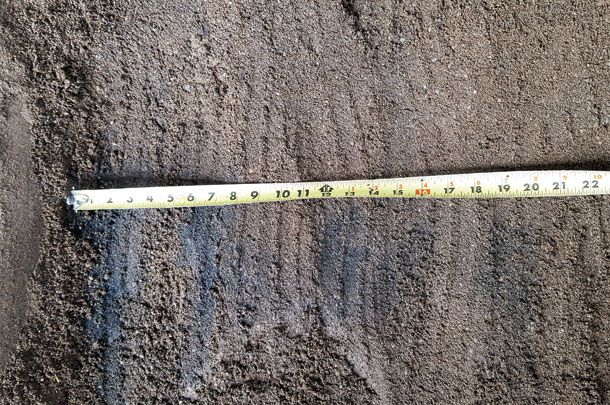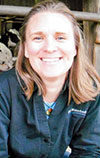We’ve all been there: lying on the couch after a nap, searching for the remote control between the couch cushions and, instead of the remote, we find a quarter, a popcorn kernel, a few blocks, a missing sock ... or something worse.
Of all of the places in the house to clean, vacuuming between the couch cushions is likely missed during your regular routine and maybe even overlooked during “spring cleaning.”
Luckily, finding lost toys in the couch is pretty harmless, but the same can’t be said for your freestalls. For all of the daily and weekly maintenance you do to keep your sand-bedded stalls clean, there may still be “lost items” lurking beneath the surface that present dangers to your cows.
Setting yourself up for success
The most difficult thing we see is that sand bedding becomes a project in and of itself, and the intense levels of stall care can’t be maintained day in and day out as the demands of the farm change during busy seasons, staffing changes, sand supply changes, budget shortfalls and weather fluctuations.

In order to ensure there aren’t dangers lurking beneath the surface, you have to fully commit to managing sand, no matter what the other factors are, to keep your cows safe and comfortable.
Have the “right” sand. The Dairyland Initiative suggests targets for ideal sand would be:
- Dry matter greater than 95 percent, organic matter content less than 4 percent
- Not too coarse and not too fine sand granular size (mason or concrete)
Have staff and time allotted to do the daily and weekly maintenance required:
- Level the top 3 to 4 inches and remove manure-laden sand during each milking.
- Add sand twice a week with at least 50 pounds of sand used per stall per day.
- Be mindful this may add additional hours to a current employee’s job or require additional staff.
Have the equipment in working order necessary to do the maintenance required:
- In smaller herds, leveling and aerating the beds can be done with hand tools, while others will choose a groomer with teeth no longer than the recommended 4 inches.
- This will require at least one skid steer.
- The additional equipment will need ongoing fuel and maintenance to function properly.
If you can’t commit to these demands of sand every week, every month and every season, sand bedding might not be the best choice for your farm, considering the increased risk to the cows.
Once you do commit to the above, here are a few additional things to look for to ensure you’re getting the cow comfort sand proponents promise.
Watch out for the ‘compaction zone’
Regardless of the type of sand used, producers should be aware of the “compaction zone.” Fine sand packs more quickly.
According to The Dairyland Initiative, “The compaction zone [is] below the surface of the top layer of sand [and] should be monitored to see if it is becoming as hard as concrete. If this gets to within 1 to 2 inches of the point of the rear curb, it is time to remove the rear third of the bed and replace it with fresh uncontaminated sand.”
With a compaction zone as hard as concrete, your sand stalls could be stealing quarters from your pocket due to decreased cow comfort.
Environmental contamination
Sand itself is said to be “inorganic,” as it does not support bacterial growth. However, organic material and liquid bonds to the surface of each particle of sand as it is dug up from the ground, used in the barn and transferred through a sand-manure separation system.
Also, the cow itself has bacteria on its skin. Klebsiella spp., coliforms, E. coli, Streptococcus dysgalactiae, Enterococcus spp. and other bacteria live in the gut, get on the cow’s body and are transferred to the sand. Cows also urinate, defecate and leak milk, which supports bacterial growth.
The Dairyland Initiative recommends bacterial counts of the following:
- Fresh bedding total count: less than 5,000 colony-forming units per milliliter, which is a measure of viable bacterial or fungal cells present
- Used bedding total count: less than 1 to 2 million colony-forming units per milliliter (mostly streptococci)
- Coliform count in used bedding: less than 100,000 colony-forming units per milliliter
How to take a bedding sample:
- Wear latex gloves.
- Sample the rear of approximately 10 stalls per pen – grabbing mostly uncontaminated bedding from the location of the udder.
- Mix in a gallon Ziploc bag, sub-sample and freeze overnight.
- Always compare used sand with fresh sand samples for a baseline.
- Ship to the lab on ice.
Teat-end health and hygiene practices in the parlor also contribute to instances of mastitis, so it’s not just one thing dairy producers need to manage. Impacts of the stall environment and parlor procedures pop up in multiple areas on the farm.
Spring cleaning
Whether we like it or not, spring cleaning should be done twice a year. That means you should remove all of the sand in (at least) the back third of your stalls twice a year. Put it on the calendar. Don’t ignore the reminders. Tie employee vacation approvals or bonus checks to getting the job done. Your cows are counting on you.
If you find your coliform count in the bedding is 100,000 colony-forming units per milliliter or greater, you need to take measures to get out the contaminated sand and get fresh sand in.
If you use fine sand, check more regularly for compaction. You’re not investing in sand bedding to have the equivalent of concrete under your cows.
Each farm is its own complex, interconnected system. Everything needs to fit together, there are multiple ways to arrange the farm system, and by stepping back and looking at multiple systems in tandem, the entire farm may see improvements with a few adjustments.
Where can you fine-tune your operation? When is the last time you dug out the back third of your stalls and replaced with new sand? What is lurking beneath your cows’ udders? ![]()
PHOTOS: These pictures were taken in the same stall by moving the surface sand away at the curb end of the stall, working close to the center (left-to-right) of the stall. Contaminated sand was discovered about 4 inches below the surface (below the top of the curb). As “clean” sand was moved away, there was a distinct layer of black sand about 5 inches below the curb (photo 1). The contaminated sand is found in the rear 20 inches of the stall (photo 2). Courtesy photos
Amy Throndsen is the chief operating officer for DCC Waterbeds. Her focus and expertise is in cow comfort in the dairy barn. Email Amy Throndsen.
References omitted but are available upon request. Click here to email an editor.

-
Amy Throndsen
- Director of Business Development
- Advanced Comfort Technology Inc.
- Email Amy Throndsen






